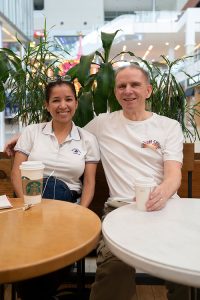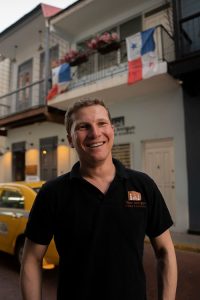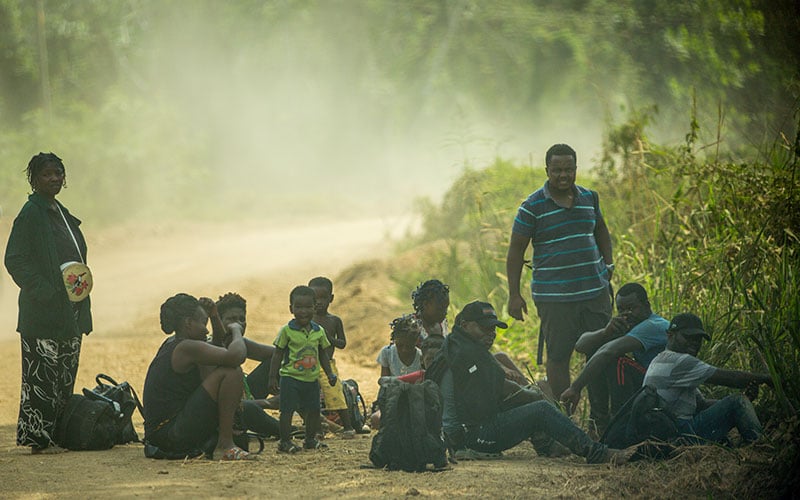
Patricia Cruz looks out over the Panama City skyline from the rooftop infinite pool on March 8 at the JW Marriott where she lives with her husband. (Photo by Marcus Xavier Chormicle/Cronkite Borderlands Project)
PANAMA CITY – Patricia Cruz and her husband, Geoffrey Godfrey, take in the view of Panama Bay from the balcony of their apartment on the 54th floor of the JW Marriott Hotel.
This is a long way from their lives in Baltimore, where they were teaching in one of the city’s toughest school districts. Now they teach at a renowned private international school in Panama City and live in relative luxury in what once was a Trump International Hotel and Tower.
“Moving to Panama was wonderful,” said Cruz, 48. “The people are warm and friendly, and the nature here is incredible.”
But like people all over the globe, the impact of the novel coronavirus has flipped life on its head for Cruz and Godfrey, 50. They now spend more than four hours on lesson plans that used to take less than an hour. They are learning how to use new technology to teach their students virtually. And they’ve faced full days of quarantine when no one is allowed outside their homes, as well as nightly curfews.

Patricia Cruz and Geoffrey Godfrey are former Baltimore teachers. (Photo by Marcus Xavier Chormicle/Cronkite Borderlands Project)
Despite the strict – some would say extreme – social distancing measures, Cruz said she is impressed how well Panama is handling the COVID-19 pandemic.
“Far better than the U.S.,” Cruz said. “Everything is closed here except groceries and pharmacies. And there is a curfew.”
For the estimated 20,000 to 30,000 Americans who live in Panama, adjusting to different laws and new rules is all part of the expatriate process.
Panama, which for decades had an extensive U.S. military presence, has long been a destination for American retirees. In February, “International Living” magazine, which focuses on Americans living abroad, ranked it second best foreign country for retirement, behind Portugal. The ranking, based on input from expats living overseas, cited its lower cost of living and the quality of affordable health care as key factors for its high ranking.
But Panama no longer is just for retirees. More young couples and professionals from the U.S., Canada and elsewhere are making the move to the small Central American country of 4.3 million residents.
The country’s economic growth is a reason why. In an October 2019 report, the World Bank said Panama has had one of the fastest growing economies in the world, with an average annual growth rate of 5.6% over the past five years.
Although Panama has made it more difficult for some groups to obtain legal status in the country, the process has remained simple and accessible for many Americans and others who have financial assets. There are many pathways to a Panamanian visa, with most requiring proof of wealth or a job already lined up in Panama. This limits accessibility for most migrants, who typically lack the means to qualify for these visas.
Cruz and Godfrey are classified as permanent residents through the International School, where they work.
“The school got us ‘permanent’ residency, which is better than a visa,” Cruz said. “But it’s kind of a misnomer. It’s not really permanent; we have to renew every five years.”
Their renewal is coming up in 2024. In Panama, 56 job classifications are reserved for Panamanian citizens – teaching is one of those professions. The International School is able to bring in foreign teachers on a maximum eight-year contract, but 50% of its teachers must be Panamanian citizens.
Panama responds to pandemic
Before the pandemic, Cruz and Godfrey finally were feeling like Panama was home, and they were finding a good rhythm. The first confirmed case was reported on March 9, according to the ministry of health, when someone who had arrived from Spain the day before went to a local hospital experiencing symptoms of the virus that causes COVID-19. Through June 29, Panama had reported 32,785 confirmed cases of coronavirus, according to the ministry of health.
“It was feeling normal – after such a big move and change in our life in 2018. Now with COVID, it is like the world has gotten smaller,” Cruz said. “We are all in this together, and so many things I missed – the shows, the art, the people – have moved online so I can see them again. That is the bright side.”
Panama implemented strict guidelines on March 22 that included a quarantine in effect from 9 p.m. to 5 a.m., and no international flights in or out of the country with exceptions for cargo, humanitarian purposes, medical supplies, medical evacuation and vaccines. Sporting events were canceled and large public gatherings prohibited. In June, flight restrictions were eased, allowing for outbound humanitarian flights and a resumption of inbound commercial flights.
Residents were assigned days and times for shopping and pharmacy trips. One person per household was allowed to leave the residence, based on gender and the last digit of the individual’s identification number on a certain day at a certain time.
When out of the house, people are required to wear masks. Men were allowed to leave the house on Tuesdays, Thursdays and Saturdays, while women were allowed to leave on Mondays, Wednesdays and Fridays in two-hour windows starting at 6:30 a.m. and finishing at 7:30 p.m.
Although alcohol sales in the U.S. have increased by 34% during the pandemic, Panama’s government on April 9 had imposed a ban on alcohol sales.
“Our quarantine seems to be more strict than most, but we are glad of that because it is the only way we can stop the spread,” Cruz said.
Schools and universities were closed nationwide, and students with internet access switched to remote learning. Students from poor neighborhoods, however, were left out.
On June 1, Panama issued revised orders replacing the strict quarantine with overnight curfews and special “movement windows.” Schools remain closed, international commercial flights remain canceled through July 22, and Panama still requires face masks in public. Events that can’t abide social distancing are prohibited, and no gathering can exceed 50 people.
Teaching from home hasn’t been easy for Cruz and Godfrey. They are learning new technology to reach their students and spending more time planning their online lessons. Events or gatherings that don’t allow for social distancing remain banned.
“It is busy,” Cruz said. “It is good because it is certainly filling our days. We are learning new tools. All the kids are getting tired of it and want to go back to school. We provided extra activities over spring break because parents weren’t sure what to do with them all day.”

Expatriates from the U.S. have been living in Panama since the construction of the Panama Canal and the subsequent buildup of U.S. military installations in the country. (Photo by Marcus Xavier Chormicle/Cronkite Borderlands Project)
Panama attracts expatriates
Cruz and Godfrey are part of an increasing trend of Americans moving to Panama for work. Those who do may qualify for the Friendly Nations Visa, which allows people from 50 countries, including the U.S., to fast-track residency visas for business reasons.
The Friendly Nations Visa has been the most popular over the past eight years, according to the government.
For the 2019 fiscal year, Panama approved 2,590 visas, a nearly nine-fold increase of the 308 approved in 2012. Meanwhile, the number of people seeking retirement visas for the 2019 fiscal year ranked only 12th among visa categories, declining from 1,409 in 2011 to 358 in 2019, reflecting the shift in reasons foreigners are moving to Panama, according to the International Organization for Migration in Panama.
The United States and Panama have a long history that dates back to 1903, after Panama declared its independence from Colombia and the new government authorized the U.S. to build the Panama Canal through the Hay-Bunau-Varilla Treaty.
The canal work was completed in 1914, and the canal became a vital part of the U.S. trade and security strategy.
In 1977, the United States and Panama signed the Carter-Torrijos Treaty that allowed the canal zone to remain under the jurisdiction of the U.S. until 1999, when it was turned over to Panama.
The U.S.-Panama relationship has had several tense periods, including in 1989, when the U.S. invaded Panama after the country’s leader, Manuel Noriega, refused to give up power after losing a presidential election.
Expatriates from the United States have been living in Panama since the building of the canal and the subsequent buildup of U.S. military installations in the country, all of which have closed. But Americans continue to flock here. Boquete, a small town in northwestern Panama, has a large contingent of Americans attracted by a tranquil and affordable lifestyle. Panama City has a soaring skyline and a cosmopolitan feel.
Major multinational corporations, including Procter and Gamble, Under Armour, Adidas, Nike and Caterpillar have their Latin American hubs in Panama City, attracting a growing workforce that increasingly utilizes the Friendly Nations Visa.

From left: Michael Styer, Felipe Osorio, Matthew Marx and Bill Bensing (photographed with wife Ines Fernandez) came to Panama for various reasons – from career opportunities to the lifestyle. (Photos by Marcus Xavier Chormicle/Cronkite Borderlands Project)
‘Once in a lifetime opportunity’
Michael Styer, 34, of Grove City, Ohio, a suburb of Columbus, works in the technology field in Panama City and has legal residency through the Friendly Nations Visa. He must renew his work permit every three years.
Styer had never been out of the U.S. until he decided to change his life after an accident. After visiting the country for a week, he moved to Panama in October 2018 and hasn’t returned to the U.S. since.
“Moving to Panama was relatively easy, but it’s been fun and a great place to live,” Styer said. “I’ve met some of my best friends and my girlfriend here, and it has been the best experience.”

Michael Styer of Ohio moved to Panama in October 2018. (Photo by Marcus Xavier Chormicle/Cronkite Borderlands Project)
Styer’s co-worker and friend, Felipe Osorio, 43, of Lincoln, Nebraska, also is a permanent resident but holds a different visa, called Contract Under 10 Percent, a type of permanent work visa.
Osorio – who was born in Buenos Aires and moved with his parents to the U.S. shortly after – has been in Panama since 2015. His company transferred him from Manila, where he had worked since 2003.
Unlike Styer, he returns to the U.S. at least once a year. Both work for the same company, based in the Panama City suburb of Colon, but they work remotely from home and go into the office only once or twice a month.
“You can’t up and move unless you take a lot of risk,” Osorio said. “This was a once in a lifetime opportunity to move to another country.”

Felipe Osorio was born in Argentina but grew up in the U.S. (Photo by Marcus Xavier Chormicle/Cronkite Borderlands Project)
Matthew Marx, 38, of Fort Lauderdale, Florida, also is in Panama on a Friendly Nations Visa, but unlike Styer, he has a permanent work visa.
Marx, a sales executive for Panama Equity Real Estate Co., has lived in Panama City for 10 years. He originally went to Panama for a two-year experiment, but within his first week there, he knew it was where he wanted to spend the rest of his life.
His job has put him in a good position to analyze trends among foreigners moving to Panama. Marx said he’s seen more younger families and young working professionals, in addition to the normal steady flow of retirees.
“But now I’m starting to see a younger wave of investors come in,” Marx said. “Just in this year since January, two of my sales were to investors that are in their young 30s.”

Matthew Marx, a sales executive for Panama Equity Reality, hails from Fort Lauderdale, Florida. (Photo by Marcus Xavier Chormicle/Cronkite Borderlands Project)
Although their numbers are declining among those seeking residency visas, retirees still make up a significant portion of American expats. Panama makes it easy with the retired or pensioned visa. To qualify, the visa applicant must show proof of a monthly pension of at least $1,000 for the rest of his or her life.
Bill Bensing, 62, of Harvey, Illinois, a suburb of Chicago, is on the retired or pensioned visa. Recently married to a woman from Peru, Bensing is loving the retired life in the San Francisco neighborhood of Panama City.
“San Francisco has it all. It’s walkable and what isn’t you can Uber for cheap,” Bensing said. “Panama City is compact but built high, so I like that. And there are no natural disasters and still has a nice warm climate.”
Bensing, who moved to Panama in May 2013, worked for Abbott Laboratories for 30 years and was transferred to multiple states during his time with the company. In California, he worked for the Rose Parade in Pasadena and still returns every year to fulfill his parade duties.

Bill Bensing is from Harvey, Illinois, and his wife, Ines Fernandez, is from Lima, Peru. (Photo by Marcus Xavier Chormicle/Cronkite Borderlands Project)
Bensing said the only drawback of living in Panama is his health care, which he must receive in the U.S. because of insurance restrictions.
“The thing I like about Panama is that I could fit in,” he said. “I speak a little Spanish but not much. … There’s a lot of expats and being able to go places and you know, (my wife) speaks Spanish for me if I need help. But it allowed me to be here to survive, so to speak, knowing English but not much Spanish. And because it’s small, I didn’t have to buy a car. I use Uber and that’s how I get around.”
Some people try to bypass the residency visa rules by entering on tourist visas. Panama moved to limit that option in March 2017. Under the new law, tourists can still stay up to five months but must leave the country for a minimum of 30 days.
David Gold, 35, of New York City, came to Panama in 2010 on a tourist visa. A Peace Corps volunteer in Bolivia from August 2006 to January 2009, Gold utilized the tourist visa before applying for permanent residency, which was granted.
He now owns his own school, Casco Antiguo Spanish School, where he teaches Spanish to individuals and companies virtually and in person in the Panama City area.

David Gold of New York City founded the Casco Antiguo Spanish School in Panama City. (Photo by Marcus Xavier Chormicle/Cronkite Borderlands Project)
Gold enjoys the perks of Panama City versus New York, such as getting to “train at a boxing gym where Roberto Duran, the famous boxer, for 10 bucks a session one-on-one” or “luxury apartments on the ocean here with four balconies overlooking the ocean, a block from where I would work, that maybe costs $1,500. That’s a lot of money in some parts of the U.S., but in New York, that’s a bedroom in a shared apartment in Queens – not even the nice part of Queens.”
Gold has done well starting his own business, but he encourages people to have a job lined up before coming to Panama because arriving without a plan can be quite a struggle.
When he moved to Panama, his parents were sure it was a phase he would grow out of. But then he sent his parents the “promo video of the school shot with drones and steady cams.”
“Like a beautifully shot movie about the school and… my dad could see it online,” Gold said. “It was like, wow, and he sent it to his friend and was like, ‘Look what my son did.'”
That’s when they realized he wasn’t coming home.
Cronkite Borderlands Project is a multimedia reporting program in which students cover human rights, immigration and border issues in the U.S. and abroad in both English and Spanish.
